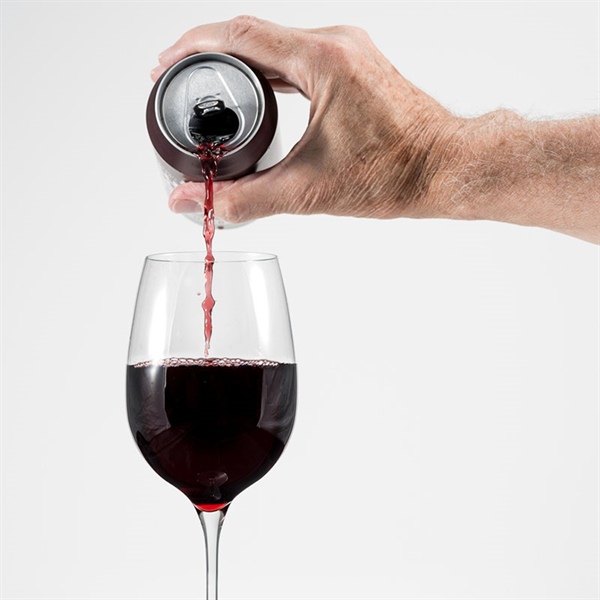One of the hottest trends in the beverage market today is, yes, canned wines. What was once considered by wine aficionados be an oxymoron is no longer a laughing matter. In 2018, Nielsen tracked canned wine sales jumping 69 percent, bringing in more than $69 million.
Around 739,000 cases in retail outlets were sold. That’s up from just $2 million in sales in 2012.
Why are canned wines so “hot?” Well, think about it:
- Canned wines are portable. You can throw them in a cooler and take them to the beach, the pool, the park or an outdoor party. For those with an active lifestyle, canned wines are perfect for hiking, boating or a post-bike ride cool off. Plus, they don’t require any accoutrements: no corkscrews, no decanters, no Riedel crystal, all the more perfect for an on-the-go beverage.
- Canned wines are ideal for someone who wants to have a glass or two of wine without opening an entire bottle. One 375ml can is the equivalent of half a bottle, or about 2.5 glasses of wine; a smaller 250 ml can holds two glasses; and an even smaller 187 ml can is comparable to one glass of wine.
- Canned wines are environmentally friendly. Cans are lighter than glass and cost less to transport. Also, aluminum cans are more recyclable. These benefits reduce the carbon footprint, appealing to today’s environmentally-conscious consumers.
So, with these plusses, what’s not to like about canned wine?
The skeptics among us wonder about the taste. To go from drinking an iconic Bordeaux in a bottle that’s been aged for 30 years — or even a California Zinfandel from a 100-year-old gnarly vine — to a quaff in a soda-pop-style can raise eyebrows. But, with all of the technological advances in the past 15 years, canned wines are no longer something to sneer at. Consider that:
- Canned wines come in lots of varieties, everything from whites to reds to rosés to sparklers. The finest canned wines are typically designed to be fresh and fruity and, in wines such as Rosé or Sauvignon blanc or Riesling, the aromatics will stay intact in a protective can that allows no oxygen to enter. When you want to enjoy wine in the great outdoors, especially on a hot summer day, canned wines offer a tasty and convenient alternative to your everyday bottle of vino.
- Canned wines may not be so great, just like some bottled wines but, according to some wine professionals, a canned wine poured into a glass will taste no different than the same wine packaged in a bottle. Also, most producers line the aluminum cans with a thin plastic liner that acts as a protective barrier, so there will be no “metallic” flavors in the wine.
- Canned wines have become so popular that even major players in the industry are getting into the act like E. & J. Gallo Winery, Treasury Wine Estates and Foley Family Wines. The Family Coppola Wines, which produced one of the first canned wines in the 2000s, sells Chardonnay, Sauvignon Blanc, Pinot Grigio and Pinot Noir for its Diamond Collection 4-Pack Cans.
- Canned wines are winning medals at wine competitions. Here at home, “Yes We Can Sway Rosé, a Texas-produced canned wine, won a gold medal at the Houston Livestock Show and Rodeo™ 2019 Rodeo Uncorked!® International Wine Competition. Canned wines now have their own competition. This July, the inaugural International Canned Wine Competition was held in Mendocino County, CA, featuring more than 200 entries from major-producing wine countries such France, Italy, Spain, Argentina, the US, Australia and New Zealand. Plans are already in the works for the second annual International Canned Wine Competition, which is scheduled for July of 2020.
- Finally, let’s talk money: Canned wines are not expensive. Costs average $4 to $7 for a 375-ml can (2.5 glasses), $10 to $17 for a four-pack of 250 ml cans (two glasses per can) and $10 to $20 for a four-pack of 187 ml cans of wine (one glass per can). Taking a can (or two) of wine to the park on a Friday night is a lot cheaper than going to a happy hour.
So, if you haven’t jumped on the canned wine bandwagon, now’s the time to try, with warm days on the calendar for a while longer and the temptation for a “tall cool one” giving way to a desire for something more substantial. On the other hand, a can of Zin might go nicely after a hike on a crisp fall afternoon, or a can of Cabernet Sauvignon might hit the spot after a long run on the way to the Houston Marathon in 2020.
With sales of canned wines exploding, the sky may be the limit in terms of possibilities. Who knows, a canned French Bordeaux or a White Burgundy may even be in your future!



